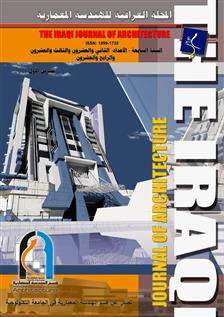Design of Horizontal Shading Devices for Baghdad city's
Abstract
The use of sun control and shading devices is an important aspect of many energy-efficient
building design strategies, where the shading of the building is the first step in the passive
cooling systems in buildings. So the starting point of cooling systems is to reduce the solar
heat gain by prevent solar radiation from entering the building in the hot period in the same
time allow the daylight and benefit from achieving passive heating in cold period.
This research interested with design of horizontal shading devices for buildings in Baghdad
city. The research problem identified as the need to study the factors influence in deign
horizontal shading devices and determining their dimensions. The research aimed to study the
horizontal shading device in simple method because this device is the most effective and most
commonly used among other types of shading devices.
The research analyses the local affecting variables comprising the outside air temperature and
intensity of solar radiation during the warm and cold months in Baghdad city.
The study prepared for architectural designer the suitable values of extending the shading
devices according to orientation, as well as the predictability of the design efficiency of all
size of shading devices placed over the windows.
The method of this research applied of design horizontal sun breakers with windows in
different orientation, which showed the space of flexibility and possibilities in the design of
shading devices.
The research reach a number of conclusions presented as guideline to assist the designers in
making decisions about the use of horizontal shading devices in different design cases.
Downloads
You are free to use the work, but you have to attribute (refer to) the work in the manner specified by the author or licensor (but not in any way that suggests that they endorse you or your use of the work).
IRAQI J. ARCHIT & PLANN grants you the right to publish the metadata of the journal, it's issues and articles under the terms of the Creative Commons Attribution-ShareAlike 4.0 International License.
Author(s) hold the copyright of their aricles without restrictions. However, IRAQI J. ARCHIT & PLANN holds publishing rights for articles and their revisions once the article is published.
Authors can archive pre-prints (ie pre-refereeing) and post-prints (i.e. final draft post-refereeing) versions of the work they submitted to IRAQI J. ARCHIT & PLANN using non-for-profit open-access servers whether on author's personal website and/or institutional repositories including the university or research center where the author work.. For post-prints, only the IRAQI J. ARCHIT & PLANN’s as-published PDF version is permitted and the published source (IRAQI J. ARCHIT & PLANN’s website) must be clearly acknowledged within the archiving webpage.






